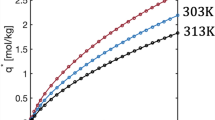Abstract
This paper presents an application of the time lag method in the analysis of an adsorption system, where dual diffusion mechanism is assumed to exist and the equilibrium relationship between the fluid and adsorbed phases is non-linear. The derived time lag is expressed in terms of system parameters and operating conditions in the form of a quadrature. The feature of this solution is that the relative contribution of the pore and surface diffusions is a strong function of upstream pressure when the time lag experiment is operated over the non-linear range of the adsorption isotherm. It is this nice feature that we take advantage of to determine the pore and surface diffusivities without resorting to isolation of the pore diffusion by using non-adsorbing gas as a reference, as usually done in many other work. This advantage is not manifested in linear systems where the relative contribution of the pore and surface diffusions is a constant, rendering the delineation of these two processes impossible. Effects of various parameters on the utility of this time lag method are discussed in this paper, and application of the method is demonstrated with experimental data of sulfur dioxide adsorption onto Carbolac carbon (Proc. Roy. Soc., A271, 1–18, 1963).
Similar content being viewed by others
References
Ash, R., R.M. Barrer, and C.G. Pope, “Flow of Adsorbable Gasesand Vapours in a Microporous Medium. I. Single Adsorbates, ”Proc. Roy. Soc., A271, 1–18 (1963).
Barrer, R.M., “A New Approach to Gas Flow in Capillary Systems, ”J. Phys. Chem., 57, 35–40 (1953).
Carman, P.C. and F.A. Raal, “Diffusion and Flow of Gases andVapours Through Micropores. III. Surface Diffusion Coefficientsand Activation Energies, ” Proc. Roy. Soc. London, A209, 38–58(1951).
Darken, L.S., “Diffusion, Mobility and Their Interrelation ThroughFree Energy in Binary Metallic Systems, ” Trans. AIME, 175, 184–201 (1948).
Daynes, H.A., “The Process of Diffusion Through a Rubber Membrane, ”Proc. Roy. Soc., A97, 286–307 (1920).
Do, D.D., “Hierarchy of Rate Models for Adsorption and Desorptionin Bidisperse Structured Sorbents, ” Chem. Eng. Sci., 45, 1373–1381 (1990).
Do, D.D., Adsorption Analysis: Equilibria and Kinetics, ImperialCollege Press, London, 1998.
Do, D.D. and R.G. Rice, “ASimple Method of Determining Pore andSurface Diffusivities in Adsorption Studies, ” Chem. Eng. Commun.,107, 151–161 (1991).
Flood, E.A., R.H. Tomlinson, and A.E. Leger, “The Flow of FluidsThrough Activated Carbon Rods. Parts I, II and III, ” Can. J.Chemistry, 30, 348–371, 372–385, 389–410 (1952).
Frisch, H.L., “The Time Lag in Diffusion, ” J. Phys. Chem., 61, 93–95 (1957).
Gilliland, E.R., R.F. Baddour, G.P. Perkinson, and K.J. Sladek, “Diffusionon Surfaces. I. Effect of Concentration on the Diffusivityof Physically Adsorbed Species, ” Ind. Eng. Chem. Fundam., 13,95–99 (1974).
Gilliland, E.R., R.F. Baddour, and J.L. Russell, “Rates of FlowThrough Microporous Solids, ” AIChE J., 4, 90–96 (1958).
Haynes, J.M. and R.J.L. Miller, “Surface Diffusion andViscous FlowDuring Capillary Condensation, ” in Adsorption at the Gas-Solidand Liquid-Solid Interface, J. Rouquerol and K.S.W. Sing (Eds.),pp. 439–447, Elsevier, Amsterdam, 1982.
Higashi, K., H. Ito, and J. Oishi, “Surface Diffusion Phenomena inGaseous Diffusion, ” J. Atomic Energy Society of Japan, 5, 24–31(1963).
Hwang, S.T., “Surface Diffusion Parallel with Knudsen Flow, ” Sep.Sci., 11, 17–27 (1976).
Hwang, S.T. and K. Kammermeyer, “Surface Diffusion in MicroporousMedia, ” Can J. Chem. Eng., 44, 82–89 (1966).
Johnson, M.F.L. and W.E. Stewart, “Pore Structure and GaseousDiffusion in Solid Catalysts, ” J. Catal., 4, 248–252 (1965).
Kapoor, A., R.T. Yang, and C. Wong, “Surface Diffusion, ” Catal.Rev. Sci. Eng., 31, 129–214 (1989).
Kraus, G. and J.W. Ross, “Surface Area Analysis by Means of GasFlow Methods. II. Transient State Flow in Porous Media, ” J. Phys.Chem., 57, 334–336 (1953).
Okazaki, M., H. Tamon, and R. Toei, “Interpretation of Surface FlowPhenomenon of Adsorbed Gases by Hopping Model, ” AIChE J.,27, 262–270 (1981).
Perry, R.H., Chemical Engineers' Handbook, 5th ed., McGraw Hill, New York, 1973.
Rajniak, P. and R.T. Yang, “Unified Network Model for Diffusionof Condensable Vapors in Porous Media, ” AIChE J., 42, 319–331(1996).
Ross, J.W. and R.J. Good, “Adsorption and Surface Diffusion of n-Butane on Spheron 6. 2700±/ carbon black, ” J. Phys. Chem., 60, 1167–1171 (1956).
Sladek, K., E.R. Gilliland, and R. Baddour, “Siffusion on Surfaces.II. Correlation of Diffusivities of Physically and Chemically AdsorbedSpecies, ” Ind. Eng. Chem. Fundam., 13, 100–105 (1974).
Tamon, H., S. Kyotani, H. Wada, M. Okazaki, and R. Toei, “SurfaceFlow Phenomenon of Adsorbed Gases on Activated Alumina, ”J. Chem. Eng. Jap., 14, 136–141 (1981).
Tamon, H., M. Okazaki, and R. Toei, “FlowMechanism of AdsorbateThrough Porous Media in Presence of Capillary Condensation, ”AIChE J., 27, 271–277 (1981).
Tsujikawa, H., T. Osawa, and H. Inoue, “Separation of Benzene andNitrogen by Permeation Through Porous Vycor Glass, ” Int. Chem.Eng., 27, 479–487 (1987).
van Amerongen, G.J., “Diffusion in Elastomers, ” Rubber Chemistryand Technology, 37, 1065–1152 (1964).
Weaver, J.A. and A.B. Metzner, “The Surface Transport of AdsorbedMolecules, ” AIChE J., 12, 655–661 (1966).
Yang, R.T., J.B. Fenn, and G.L. Haller, “Modification to the HigashiModel for Surface Diffusion, ” AIChE J., 19, 1052–1053 (1973).
Author information
Authors and Affiliations
Rights and permissions
About this article
Cite this article
Do, D., Do, H. Analysis of Dual Diffusion and Non-linear Adsorption Isotherm with a Time Lag Method. Adsorption 6, 111–123 (2000). https://doi.org/10.1023/A:1008959517075
Issue Date:
DOI: https://doi.org/10.1023/A:1008959517075




